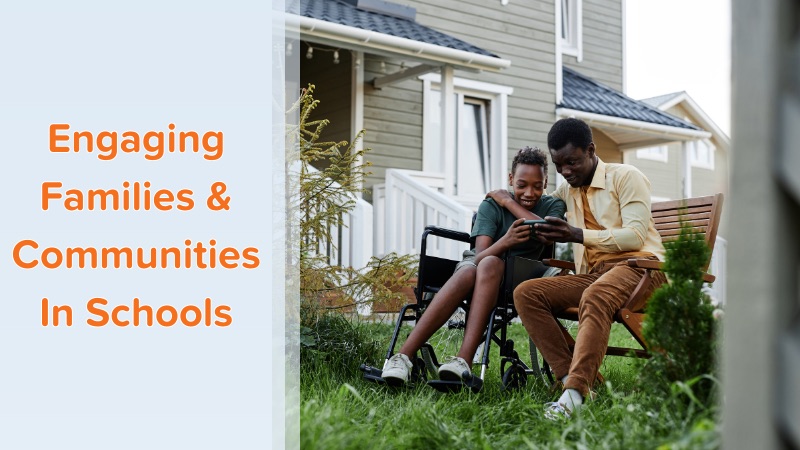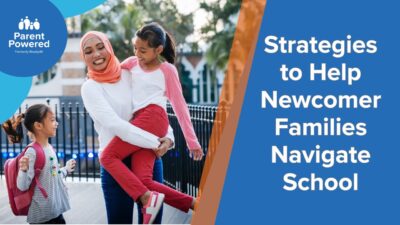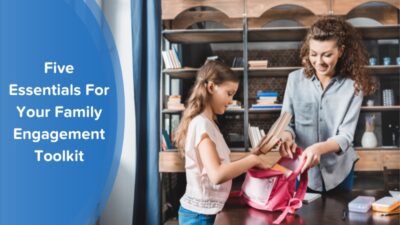By Megan Okrand, contributing writer
When envisioning family and community engagement in schools, often the first image that springs to mind are bake sales. A charming tradition, indeed, where cookies and brownies do the talking. But let’s pause for a moment and ask ourselves: can community engagement truly be encapsulated in the aroma of freshly baked treats?
Yes it can!
Defining community and family engagement
Community engagement, in the context of schools, goes beyond the traditional bake sales and open houses. It’s a multifaceted concept that encompasses building meaningful relationships and partnerships between schools, families, and the surrounding community. It’s about two-way communication, collaboration, and shared power, all aimed at enriching the educational experiences of students. In essence, community engagement is the active involvement and cooperation of various stakeholders, including families, schools, and local community groups, in support of a common goal: student success.
Although I think I can speak on behalf of most educators when I say that we do love a pastry (or two), family and community engagement is not just about cakes and pies. Creating a dynamic partnership where everyone contributes to the recipe of triumph is the true essence of meaningful engagement.
Benefits of family and community engagement in schools
In education, family and community engagement isn’t just a desirable bonus; it’s a game changer. There are myriad ways this collaboration benefits students, families, and schools, while also playing a pivotal role in educational equity.
Benefits to Students
- Improved Academic Performance: When families are actively engaged in a student’s education, it often results in higher academic achievement. Students receive more support with their homework, have better study habits, and show increased motivation to succeed academically
- Enhanced Behavioral Outcomes: Engaged families play a pivotal role in shaping positive behavior in students. They provide the support and guidance needed for children to thrive socially and emotionally.
- Increased Graduation Rates: High school graduation rates tend to rise when families take an active role in their child’s education. The encouragement and guidance provided by engaged families can help students stay on track to earn their diplomas.
Benefits to Families
- Strengthened Child-Parent Relationships: Family engagement isn’t just about academics; it’s about bonding. When parents actively participate in their child’s educational journey, it strengthens the parent-child relationship, fostering trust and open communication.
- Access to Supportive Resources: Engaged families often gain access to a network of resources and support provided by the school and community. This can include information on nutrition programs, healthcare services, and educational workshops.
Benefits to Schools
- Enhanced School Climate: Schools with active family engagement programs often have a more positive and inclusive atmosphere. When students and families feel supported and valued, the overall school climate improves.
- Improved Teacher Satisfaction: Teachers benefit from family engagement as well. When parents are involved, teachers can build stronger relationships with students’ families. This leads to greater job satisfaction and a sense of shared responsibility for student success.
- Increased School Readiness: When families are engaged, students are more likely to come to school prepared and ready to learn. This can result in fewer disruptions in the classroom and a smoother learning experience.
For these benefits to come to fruition, effective family engagement in schools centers on establishing a collaborative bond between schools and families. This approach is outlined in the Dual-Capacity Building framework, developed by Dr. Karen Mapp at the Harvard Graduate School of Education.
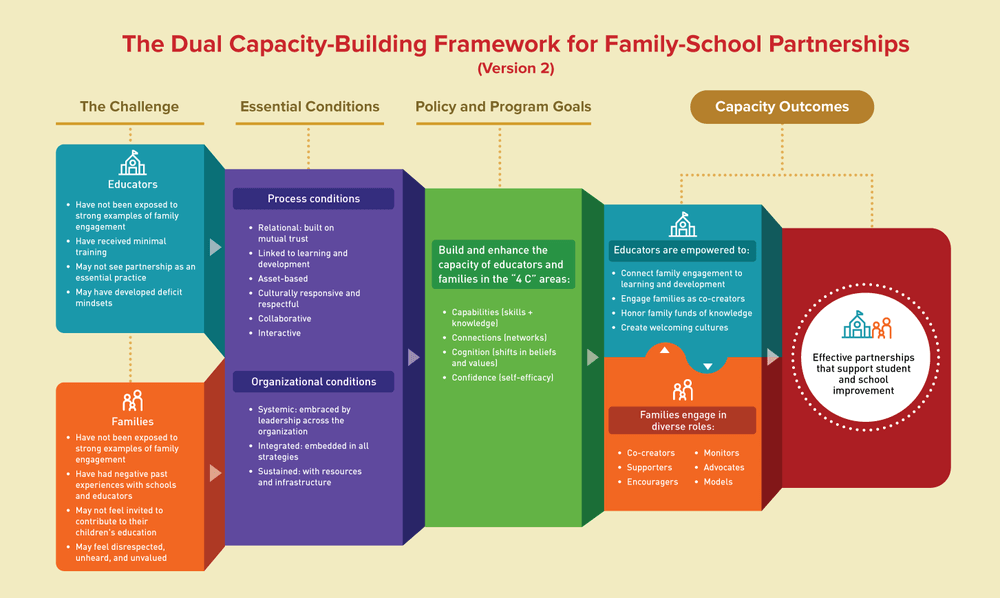
When a school adheres to this framework, several pivotal components come into play:
- Teachers and staff actively incorporate parents and caregivers as integral members of the learning team.
- The rich tapestry of family knowledge, cultures, and traditions is not merely acknowledged but celebrated, infusing the school and classroom environments with diversity.
- Authentic parental involvement seamlessly becomes part of the decision-making process.
- A robust foundation of trust is nurtured, fostering a robust and enduring connection between the school and the home.
So, the real question emerges: What practical strategies can we put into action to truly enable transformative family and community engagement in schools?
Strategies for building trust and relationships with families
Building trust and fostering trusting relationships start with acknowledging that every family is unique and brings their own strengths to the educational journey. Rather than viewing families as needing “fixing,” educators can empower parents and caregivers as essential partners in education.
This shift is marked by the cultivation of mutual respect, trust, and cultural humility — the foundation of building trusting relationships — and is significantly reinforced through active community engagement. By doing so, educators and families together pave the way for a successful partnership.
Engaging families in learning
Learning doesn’t stop when the school bell rings. Empowering families to become active partners in their child’s education begins with embracing the potential of learning beyond the classroom.
- Flexible Community-Centered Workshops: Schools can offer workshops and learning sessions that accommodate diverse schedules. Consider providing options during evenings,weekends, or online, allowing families with busy schedules to participate. Focus some workshops on topics that resonate with the community, like local environmental issues, cultural heritage, or community development projects.
- Bite-Sized Learning: Not all families have extensive free time for workshops. With this in mind, schools can encourage families to incorporate learning into their daily routines with small, manageable activities that can be done in short bursts. ParentPowered’s text messages provide at-home learning activities and they are designed to evolve with your child, offering educational content for families and their students from birth through high school.
- Digital Accessibility: Schools can utilize technology effectively, ensuring digital accessibility for all families. Consider providing resources and support for families who may not have easy access to technology or face digital literacy challenges. Collaborate with local libraries or community centers to facilitate access to digital tools and learning resources.
- Community Events and Projects: Schools can host and participate in community events or projects, like cultural festivals or local improvement initiatives. These activities foster a sense of belonging and mutual investment in the community and school.
By implementing these approaches, schools can create an inclusive and welcoming environment where all families feel valued and empowered as partners in their children’s education.
Empowering families as partners
As families begin to engage more actively, the focus naturally shifts towards ensuring they become true partners in the decision-making process. Authentic family engagement is deeply rooted in the concept of shared power and collaborative decision-making, fostering a sense of responsibility and community pride. It’s important to recognize that this transition is another mindset shift that takes time to cultivate. Starting small is perfectly okay; even minor steps towards this collaborative approach can lead to significant progress.
Involvement
Creating opportunities for open dialogue between educators and families can help build trust. Consider hosting regular meetings where both parties can discuss their expectations and roles. Integrate topics that resonate with the community, encouraging discussions that reflect local cultural, social, and economic contexts. For added accessibility, make sure these meetings are available virtually through platforms like Zoom, accommodating parents who might find it challenging to visit the school in person.


Engagement
To deepen engagement, it’s essential to enhance accessibility and inclusivity. For multilingual families, providing language translators at meetings ensures that all families can fully participate and contribute. Additionally, educators engaging in open dialogue with families and practicing active listening is vital. These approaches allow for a more personal connection and a richer understanding of families’ diverse needs and aspirations.
Empowerment
Empowering families involves educators gaining a deeper understanding of diverse family backgrounds. This can be achieved through cultural humility and sensitivity training, enabling educators to respect and appreciate the unique perspectives and values families bring. Encouraging educators to actively seek feedback from families through surveys, suggestion boxes, or open forums makes families feel heard and respected. These tools should be community-centric, focusing on how the school can serve broader community needs.


Leadership
Educators are often making decisions and communicating them out to parents; why not consider establishing parental advisory boards as part of making decisions? These forums can provide families with the opportunity to participate in school policy discussions. When families are actively engaged, they become an integral part of shaping the school’s future. Furthermore, promoting student agency through student-led conferences allows students to share their learning progress and goals, creating a sense of ownership in their educational journey and laying the groundwork for future leadership.
Encouraging gradual involvement and celebrating small victories along the way can help build the foundation for a robust partnership between families and schools.
Strategies to connect with the community
Education doesn’t happen in isolation. Schools that embrace their surrounding communities as partners in education unlock a world of possibilities for their students. By fostering meaningful relationships and creating an enriched school environment, they ensure that education extends far beyond the classroom walls.
Connecting with the community by partnering with local organizations
Collaborating with local professionals and organizations is like adding a secret ingredient to a recipe – it elevates the overall flavor (and turns that standard bake sale into a gourmet culinary experience). When schools tap into the expertise and resources within their community, students gain invaluable insights, and the benefits are boundless. For example:
- Guest Speakers and Mentors from various industries breathe life into classroom lessons. Imagine a local engineering firm partnering with a high school to create a STEM mentorship program or a successful entrepreneur sharing their journey, igniting students’ entrepreneurial spirit.
- Community Internships and Career Exploration Programs offer hands-on experiences that bridge the gap between theory and practice. Students can explore potential careers and develop essential skills under the guidance of experts.
- Local Organizations can provide resources, such as access to modern technology, internship opportunities, or even funding for educational initiatives. The local library, for example, could team up with schools to provide reading programs, access to e-books, and even homework help sessions. This partnership not only enhances students’ reading skills but also makes educational resources accessible to all.
Strengthening the school-community bond
A sense of belonging is vital for every student’s growth. Strong relationships between schools, families, and the community form the bedrock of an enriched educational experience. These connections extend beyond the school gates, nurturing an environment where everyone feels valued and involved.
Scaffolding Family Engagement
Scaffolding family engagement is about more than planning traditional parent-teacher conferences; it actively involves parents in their child’s education through insightful and supportive roles. Family engagement programs include workshops for parents on curriculum understanding and at-home learning strategies, with the added flexibility of virtual access for those unable to attend in person.
ParentPowered supports this approach by delivering a whole-child development curriculum directly to families via text message. Each message is carefully crafted with practical tips and activities based on scientific research, fostering healthy child development and providing continuous learning opportunities. This method not only facilitates consistent engagement but also empowers parents to be active, informed participants in their child’s educational journey
Community-Based Outreach
School staff can take a proactive approach by reaching out to families in their communities rather than expecting families to come to the school. For example, teachers or parent liaisons could visit local community centers, libraries, or neighborhood events to connect with parents, share information, and offer support.
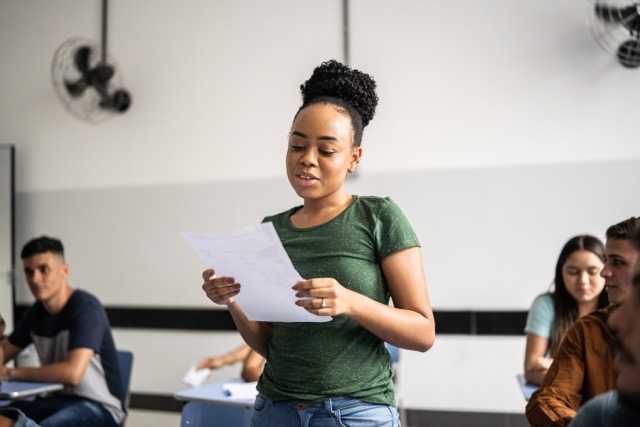
Resource Libraries
Schools can set up resource libraries within the community, such as at local libraries or community centers. From mental health tools and counseling resources to educational materials, these libraries become hubs of holistic support, empowering families with the knowledge and tools they need to nurture both their children’s academic success and overall well-being.
Establishing meaningful connections and partnerships among schools, families, and communities isn’t just important — it’s what makes education transformative. These connections promote student success by providing a strong support system that positively impacts academic and overall well-being. And let’s not forget an added bonus: these partnerships help equip students with life skills, the know-how to tackle life’s ups and downs. They foster an inclusive learning environment where diversity is celebrated, and shared responsibility among stakeholders ensures effective decision-making and holistic development.
Schools, families, and communities become a united front, offering invaluable resources like mental health services and mentorship programs, and setting a powerful example of trust, communication, and community investment. The result? A dynamic, engaging, and truly enriching educational experience that benefits everyone involved.
Strategies to overcome barriers and ensure equity
To truly unlock the potential of family and community engagement, we must shift our focus towards equity. This means recognizing that not all families have the same starting point in their engagement journey.
By adopting an equity-focused approach, we acknowledge the importance of reaching traditionally marginalized groups and underserved communities. We go beyond being reachable to actively and appropriately reaching out to families who may have been overlooked or even harmed by the educational system in the past.
Shifting towards equity: breaking down the walls
Removing barriers is a tangible step towards fostering meaningful family and community engagement. Transportation challenges, childcare hurdles, and language barriers are common stumbling blocks on this journey. Let’s explore strategies to tackle these issues head-on, making engagement more inclusive and accessible.
- Ensuring Basic Needs Are Met: Equitable engagement often begins by addressing the basic needs of families. For many, these needs present significant barriers to participating in their children’s education. Strengthening the school-community bond by incorporating initiatives like community-based outreach and resource libraries are tangible examples of how schools can meet families where they are, both physically and in terms of their needs.
- Addressing Transportation and Childcare Challenges: Recognizing that busy schedules and logistical concerns can deter families from engagement, schools can offer childcare options for school events or transportation assistance like setting up carpools. Even better, schools can hold events in community spaces that are more accessible to families. These measures ensure that no family is left behind due to practical hurdles.
- Extended Library Hours: Schools can extend the hours of their libraries or resource centers or partner up with community centers, offering a quiet and supportive environment for parents and students to engage in academic activities or attend workshops outside of regular school hours.
- Multilingual Communication and Resources: Language does not need to be a barrier to engagement. Schools can provide multilingual communication and resources, ensuring that all families receive information and have opportunities to participate in their preferred language. ParentPowered stands out for its linguistic diversity, offering its family engagement curricula in 10 different languages. This isn’t just a simple word-for-word translation; each message is thoughtfully adapted for cultural and contextual relevance, ensuring a more genuine and effective user experience.
- Online Workshops and Resources: Create an online repository of resources, including recorded workshops, informational videos, and downloadable materials, allowing parents to access valuable information and support at their convenience.
- Collaborative Planning: Involve parents and caregivers in the scheduling and planning of school events. Their input can help identify convenient times and locations that work best for the community.
In addition to action-oriented text messages, educators using ParentPowered are equipped with a variety of resources to support family engagement in their child’s learning and in school programs. Educators have access to informative webinars and ‘modeled moments’ videos, which they can share with families.
These resources showcase a range of enjoyable and educational activities that families can easily incorporate into home learning. This blend of visual and text-based content enhances the learning experience, making it more dynamic and effective for families.
Culturally responsive engagement
Cultural diversity enriches the tapestry of our school communities. However, cultural proficiency goes beyond mere tolerance; it embraces, respects, and empowers families from diverse backgrounds. By understanding and appreciating diverse backgrounds, schools can foster a sense of belonging and empower families from all walks of life.
Cultural Celebrations
Schools can celebrate the richness of their student body by showcasing diverse backgrounds. Cultural heritage celebrations foster an atmosphere of inclusivity and appreciation, where students and families feel valued for their unique contributions.
Funds of Knowledge
Recognizing that families possess a wealth of knowledge, especially about their children, schools should incorporate these “funds of knowledge” into their curriculum. Developed by Dr. Luis Moll, the concept “Funds of Knowledge” represents the vital cultural practices and deep-seated knowledge inherent in the daily routines and activities of families. When families see their culture and experiences reflected in their child’s education, engagement becomes more meaningful.
Engaging Community Groups
Reflecting the diversity of the student body, schools can actively seek out community groups that represent various cultural, linguistic, and socioeconomic backgrounds. A great way to build trust with these groups is to identify parents or caregivers who are part of both cultural/community groups and the school community. Educators can establish partnerships with these parent leaders to foster broader trust and engagement from families who already know and trust those leaders.
Similarly, this approach can be extended to collaboration with community organizations. By partnering with organizations that families are familiar with and trust, schools can set a strong foundation for success in establishing trusting relationships with families. Collaborating with these groups not only fosters equity but also strengthens ties between the school and the broader community.
This approach transcends traditional engagement methods, weaving a fabric of inclusivity that enriches both the educational experience and the broader community. As schools chart this path forward, it’s important to continue to listen, adapt, and innovate, ensuring that the school environment reflects the vibrant diversity and potential of every family they serve.
Growing together in our school communities
Our school communities are wonderfully diverse, and it’s through this diversity that we find strength. From workshops to cultural events and community collaborations, each element plays its part in fostering an environment where everyone’s contribution is valued and essential for student success. Family engagement is hard work – much harder than baking and eating. But it’s worth it. Robust family engagement is like having your cake and eating it too!
It’s also important to take a moment to appreciate our achievements, both large and small. Celebrating these milestones is more than recognition; it’s a way to keep our spirits high and maintain our momentum. Moreover, staying adaptable and open to feedback is key. Continuously refining engagement strategies helps schools meet the changing needs of their school communities effectively.
ParentPowered makes it easy to refine engagement strategies. The ParentPowered Dashboard simplifies digital family engagement by providing an efficient way to enroll families in the curricula, manage enrollment, assess program impact, and create high-quality visualizations for presentations and stakeholders.
Additionally, ParentPowered regularly gathers family feedback to guide program improvement and allows educators to send brief, text-based surveys for quick feedback. This efficient system ensures educators can easily adapt to family needs, enhancing the effectiveness of family engagement.
Are you inspired to be part of this positive change? Learn how ParentPowered can help you actively engage with families in your school community.
About the author
Megan Okrand is a former High School History teacher turned writer taking her passion for education outside of the classroom and into the World Wide Web. Megan holds a master’s degree in secondary education and teaching from the University of Southern California as well as a master’s degree in art history, criticism, and conservation from University of North Carolina, Chapel Hill. Connect with her on LinkedIn.

